
Back Gimnopèdies Catalan Gymnopaedie German Gimnopedias Spanish Gymnopaidiai Finnish Gymnopédies French Gimnopedie Italian Gymnopedia Polish Gimnopédia Portuguese Гимнопедия Russian
The Gymnopaedia was an annual festival celebrated exclusively in ancient Sparta, which helped to define Spartan identity.[1][2] It featured generations of naked Spartan men participating in war dancing and choral singing, with a large emphasis placed on age and generational groups. It is believed that celebration of this festival began in 668 BCE to honour a Spartan victory in Thyrea.[3] The festival likely evolved over time to celebrate other Spartan victories such as that over the Argives in the Battle of the Champions.[4] The Gymnopaedia was primarily in honour of Apollo, but also celebrated Artemis and Leto, who served as representations of the childhood which would soon be left behind by the young participants.[5] Though the festival was ritualistic, it should not necessarily be interpreted as religious.[6] Pausanias describes the Gymnopaedia as "a festival which the Lacedaemonians take more seriously than any other" (Paus. 3.11.9).[7]

- ^ Robertson, Noel. Festivals and Legends. pp. 147–166. ISBN 978-1-4426-7485-1. OCLC 1013950783.
- ^ Powell, Anton; Flower, Michael A. (2018). "Spartan Religion". A companion to Sparta. Wiley-Blackwell. pp. 425–451. ISBN 978-1-4051-8869-2. OCLC 1029549436.
- ^ Wade-Gery, H. T. (1949). "A Note on the Origin of the Spartan Gymnopaidiai". The Classical Quarterly. 43 (1/2): 79–81. doi:10.1017/S0009838800027774. ISSN 0009-8388. JSTOR 637221. S2CID 170294020.
- ^ Daniel, Ogden (February 2010). A companion to Greek religion. ISBN 978-1-4443-3417-3. OCLC 460062268.
- ^ Noel, Robertson (1996). Festivals and legends: the formation of Greek cities in the light of public ritual. Univ. of Toronto Press. pp. 147–165. ISBN 0-8020-5988-0. OCLC 830654658.
- ^ Flower, Michael A., "SPARTAN 'RELIGION' AND GREEK 'RELIGION'", Sparta, The Classical Press of Wales, pp. 193–230, doi:10.2307/j.ctvvnb97.8, ISBN 978-1-910589-33-5, retrieved 2021-04-02
- ^ "Pausanias, Description of Greece, Laconia, chapter 11, section 9". www.perseus.tufts.edu. Retrieved 2021-04-02.
© MMXXIII Rich X Search. We shall prevail. All rights reserved. Rich X Search